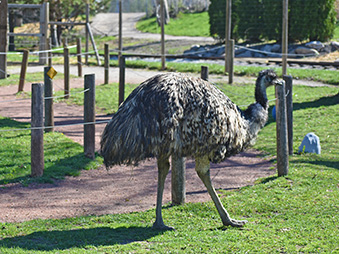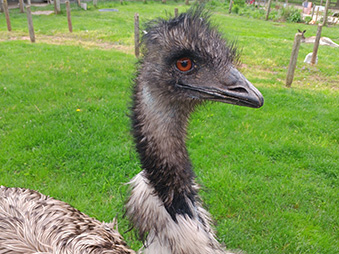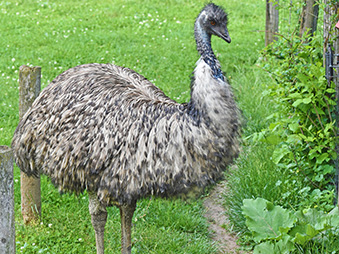Dromaius novaehollandiae | Emu
Name: Penelope (Male)



Meet Penelope: Our Speedy, Feathered Friend
Say hello to Penelope—yes, he’s a male despite the name! Born in 1997, Penelope is our longtime Outback ambassador and living proof that birds don’t need to fly to be extraordinary.
With powerful legs, shaggy feathers, and a big personality, Penelope is built for action. He can sprint up to 30 mph, leap 7 feet straight into the air, and deliver a kick strong enough to stop a predator in its tracks. And if you’re lucky, you might catch him enjoying his favorite enrichment snack: grapes!
Built for the Outback
Native to Australia, emus are highly adaptable birds found across nearly every habitat on the continent, except dense rainforests and the most barren deserts. To survive in such a wide range of conditions, they’ve developed some remarkable adaptations:
Feathers with a Purpose
Though flightless, emus are fully feathered. Their loose, shaggy feathers have separated barbs that help regulate body temperature and provide excellent sun protection—perfect for Australia’s harsh climate.
Leg Day, Every Day
Emus have powerful legs and unique calf muscles that give them speed, explosive jumping ability, and some of the strongest kicks in the bird world.
Heat-Smart Survivors
Emus are diurnal, meaning they’re active during the day, but they’ve learned to time their movement around the cooler hours of dawn and dusk to beat the heat.
Desert-Ready
They can store fat to use for energy and hydration during long stretches without food or water—a particularly important trait for nesting males.
Dad of the Year
In the emu world, the dads do all the heavy lifting—literally.
After a female lays her eggs, she moves on, and the male takes over completely. Once incubation begins, he becomes a full-time guardian, refusing to eat, drink, or even pass waste for nearly 48-56 days. During this time, he relies entirely on stored body fat and can lose up to 50% of his body weight.
After the chicks hatch, the father continues to care for and protect them—sometimes even from the mother! It’s a powerful example of parental dedication and an impressive case of parental care in the animal kingdom.
A Role in the Ecosystem
Emus are large birds that play a key role in shaping the ecosystems they inhabit. As they forage, they help disperse seeds and cycle nutrients, which benefits the plant communities around them. Emu are considered omnivorous because they eat both plants and other animals.
Because of their size, adult emus have very few natural predators. Only humans and dingoes are large enough to hunt them. Dingoes, like wolves in North America, are keystone predators—species that help keep populations like emus and kangaroos in check. Without them, populations can get out of hand, threatening biodiversity.
Why does biodiversity matter? A healthy, diverse ecosystem provides cleaner water, richer soil, and greater overall resilience to environmental change.
The Emu War: Stranger Than Fiction
In 1932, emus made headlines for all the wrong reasons. With the decline of the dingo population and no emu population management strategy in place, they flourished and began wreaking havoc on farmlands, damaging crops when food insecurity was at an all-time high globally (The Great Depression). This invasion sparked a military response known as the Emu War.
Armed with heavy ammunition, the Royal Australian Artillery attempted to cull 20,000 birds—but the effort failed, becoming too expensive for the minimal result. Emus proved too fast, too agile, and too tough. After two months of attempted population control, the campaign was abandoned in favor of non-lethal management strategies.
Today, Australia uses fencing and population monitoring and management to control emu numbers more effectively. The Emu War remains a fascinating (and slightly humorous) example of how unchecked prey populations can become problematic when there are too few predators to manage them properly. It is also a reminder of why effective wildlife management needs to come from scientists and qualified individuals within our government.
Fact Sheet
Taxonomy
Genus: Dromaius | Species: novaehollandiae |
Kingdom: Animalia | Phylum: Chordata | Class: Aves | Order: Casuariiformes | Family: Dromaiidae |
Favorite Enrichment Type
Grapes!
Life Span
- In the Wild: 10 to 20 years
- In Human Care: Up to 35 years
Diet
- In the Wild: Fruits, seeds, grasses, shoots, insects, and small animals
- At the Zoo: Mazuri® Emu Maintenance, fresh fruits, vegetables, and hard-boiled eggs
Geographic Range
Found throughout Australia in almost all habitat types, except for rainforests or arid deserts.
Habitat
Found in savannah forests, grasslands, and subtropical climates.
Fast Facts About Emus
- Big Birds: Emus are the second-largest birds in the world and can grow up to 6.5 feet tall.
- Built for Speed: They can run up to 30 mph and jump 7 feet in the air.
- Father Figures: Male emus incubate eggs for 48-56 days without eating, drinking, or passing waste.
- Powerful Kicks: Emus use their legs for defense, delivering strong, accurate strikes when threatened.
- Survival Pros: Their specialized feathers and fat storage make them well-adapted to hot, dry climates.
- History Makers: Emus were at the center of the real-life “Emu War” in 1932—and won.
Status: Least Concern
Conservation & Coexistence
Ecosystems can be incredibly delicate, and predator control—especially lethal control—can disrupt this balance. Thankfully, non-lethal alternatives are on the rise. In both Australia and parts of Africa, livestock guardian dogs are used to protect farms from predators without harming native species. These smart solutions help people and wildlife coexist.
Penelope’s Message: Balance is Key
Though emus are currently listed as Least Concern, their story underscores the importance of ecological balance. Whether it’s maintaining predator-prey relationships or finding new ways to coexist, thoughtful conservation leads to healthier ecosystems for everyone—humans and animals alike.
How to Find Me
Looking to meet Wedgie? Head on over to our Aviary, nestled between our Outback viewing deck and the white-throated capuchin habitat. You can find her in one of the side habitats, viewable from the outback viewing deck! If in a talkative mood, you will be able to hear her throughout the zoo!
